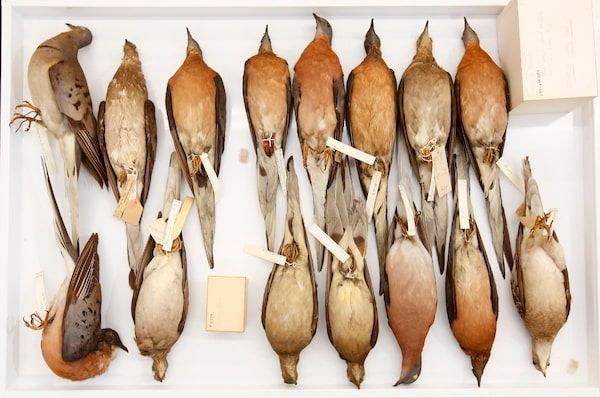
In this photo taken April 23, 2018, passenger pigeons are viewed at the Museum of Biological Diversity, Ohio State University, in Columbus, Ohio.Tom Dodge/The Associated Press
One of the most terrible and astonishing tales of a species’ extinction is that of the North American passenger pigeon.
When the first Europeans arrived on the continent, there were as many as five billion of the nomadic birds roosting and migrating in giant flocks that numbered in the millions. The birds were so abundant that Indigenous people could hunt them by throwing sticks and rocks into the air. Settlers recounted not having to bother to aim their shotguns; a single blast into the air could kill six or more at once.
The pigeons’ abundance appeared unending, and their extinction happened so quickly at the end of the 1800s that few noticed until it was over. As a new study on the dramatic decline of bird populations in North America over the past 50 years put it last week, the fate of the passenger pigeon is “a poignant reminder that even abundant species can go extinct rapidly.”
The study, published last week in Science magazine, estimates that 2.9 billion birds of various species have disappeared in Canada and the United States since 1970 – a population decrease of 29 per cent.
The study is different from others in the sense that it doesn’t focus on extinction – the usual subject of doomsday ecological reports – but instead on “loss of abundance within still-common species.”
As the report says, had there been systematic reporting about declines in the population of passenger pigeons in the 1800s, the extinction of the species might have been avoided. The lack of reporting, combined with the fact that human-caused extinction wasn’t something people were familiar with at the time, sealed the passenger pigeon’s fate.
Today we know better. Conservation and environmental protection have been international concerns since the 1970s. And just last May, a United Nations study said that one million animal and plant species face imminent extinction because of human activity and climate change.
That report, by the Intergovernmental Science-Policy Platform on Biodiversity and Ecosystem Services, found that three-quarters of the land on the planet has now been “severely altered” by human actions, as has 66 per cent of Earth’s marine environment. Most frightening of all, 85 per cent of the planet’s wetlands have disappeared.
In all this, birds are the literal canary in the coalmine of habitat destruction and pesticide overuse. “Birds are excellent indicators of environmental health and ecosystem integrity,” the Science report points out.
The new study is, in fact, just the latest to sound the alarm about avian die-off in North America. A report released in June said that 25 per cent of the bird species in Canada face precipitous decline. A similar report from 2016 on birds in the United States found that half the species of ocean and tropical-forest birds were in crisis, while coastal and grasslands species were in steep decline.
Other studies in Europe have reported similar declines in bird populations, usually due to loss of habitat to agriculture and the use of toxic pesticides.
In North America, some of the biggest declines in population are occuring in the boreal forest and tundra, both of which are specific to Canada. Species in our Prairie grasslands and western forests are also in danger.
You don’t have to be a scientist with a notepad to be aware that birds are dying off. It’s a fairly routine observation these days that songbird chatter in the morning and evening isn’t what it used to be, and that the numbers of many common species – sandpipers, warblers, orioles, blackbirds, swallows and starlings – are noticeably smaller.
The question now is what to do, and the answer is self-evident. While many species of North American birds are in decline, others that were once struggling are now thriving. Populations of birds of prey, such as eagles, and of waterfowl have increased dramatically since the 1970s, owing to the banning of the pesticide DDT and efforts to preserve habitats and wetlands.
A similar effort is now required in the grasslands and forests of Canada. Ottawa and the provinces need to protect habitats through better farming, forestry and industrial practices, and to ban the use of pesticides in areas where nesting and migrating birds congregate. Efforts to mitigate climate change and protect ocean habitats are also critical.
The only sin would be to fail to act. Science has given us the data we need. The passenger pigeon was killed off by ignorance – we don’t have that excuse today.